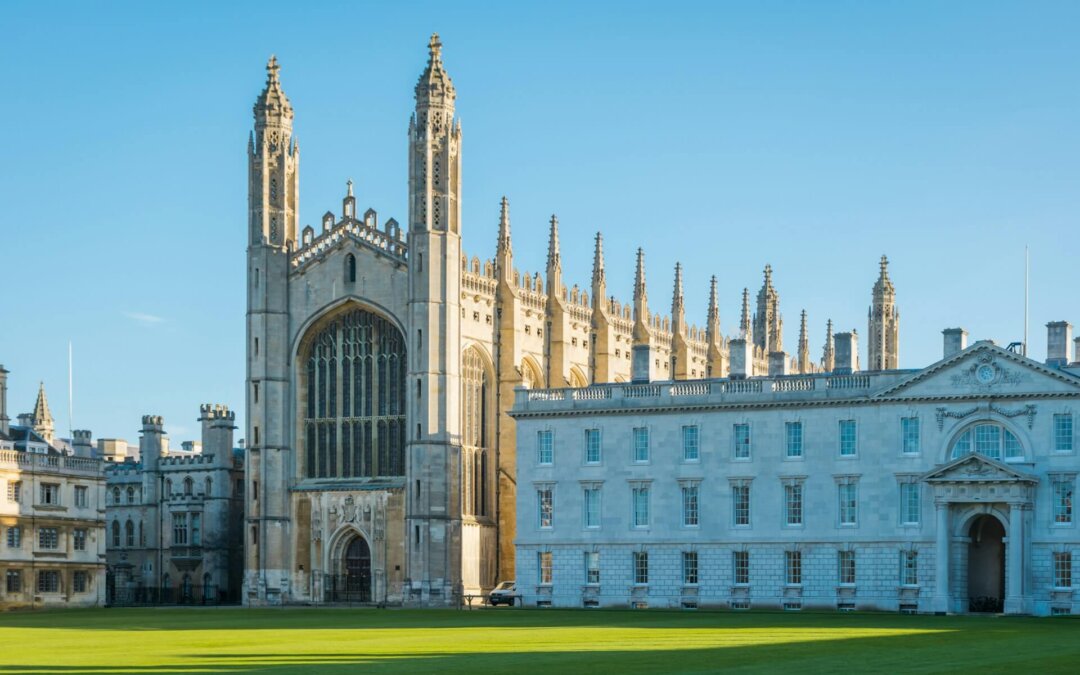London is the city of double-decker buses, red phone booths, and that unmistakable blend of history and modernity. With so many iconic landmarks, no one would fault you for spending your entire trip exploring these. But let’s be honest—sometimes even Big Ben needs a break!
If you want to step beyond the UK’s capital hustle and bustle, you’ll find charming towns, historical sites, and natural beauty, all within a day’s reach. Leveraging London’s extensive rail network, you can conveniently trade city skylines for rolling countryside, seaside vistas, or cobbled streets of ancient cities.
Whether you’re a history enthusiast, nature lover, or just looking for a leisurely day out, these day trips promise to enrich your UK travel itinerary.
Related: Top Neighborhood to Visit in London
Oxford
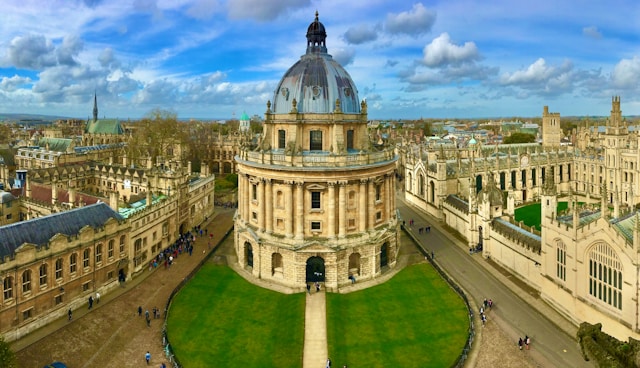
Nestled amidst the rolling meadows of the Cotswolds, Oxford beckons with its centuries-old charm and vibrant student energy. This captivating city, home to the world-renowned University of Oxford, is a perfect destination for a day trip. Whether you’re a bookworm, a film buff, or simply seeking a dose of enchantment, Oxford delivers.
Walking Tour
A walking tour is almost always a great way to get a good introduction to a new city. There are several walking tours, bike tours, and bus tours that you can take while in Oxford. You can opt for one that covers the historical downtown, The Covered Market, Radcliffe Square, and some of the University of Oxford buildings. Vantage points like Carfax Tower and the University Church of St. Mary the Virgin offer stunning views of the cityscape. You can also take a walking tour exploring the University of Oxford’s iconic colleges, each with its own unique charm and history. In addition to these more general city tours, there are also other Oxford tours focused on the town’s history, literature, Harry Potter, architecture, etc.
Museums and Historical Sites
Immerse yourself in the city’s scholarly atmosphere by visiting its numerous museums. From the Ashmolean Museum to the Pitt Rivers Museum, there’s something for every interest, including art, history, and natural sciences. There are also regular exhibitions happening all over the city, both in and out of museums, so be sure to check to see what is on during your visit. If you want to delve deeper into Oxford’s rich history, visit Oxford Castle, where guided tours reveal its intriguing past as a prison. You can also venture outside the city to visit Blenheim Palace, a UNESCO World Heritage site and birthplace of Winston Churchill.
Outdoors
Oxford sits at the confluence of two rivers, the mighty Thames and the Cherwell, and the city owes its early development to the presence of these two rivers. While the nude bathing spots found along the river are closed, visitors can still enjoy river boat trips as well as punting on the rivers. Alternatively, take a break in Oxford’s green spaces, such as University Park and the Oxford Botanic Garden & Arboretum, to relax amidst nature. Make sure to leave some time to unwind at one of Oxford’s many traditional pubs or indulge in afternoon tea for a taste of British culture.
Related: What is Your Personal Cruise Style?
Cambridge
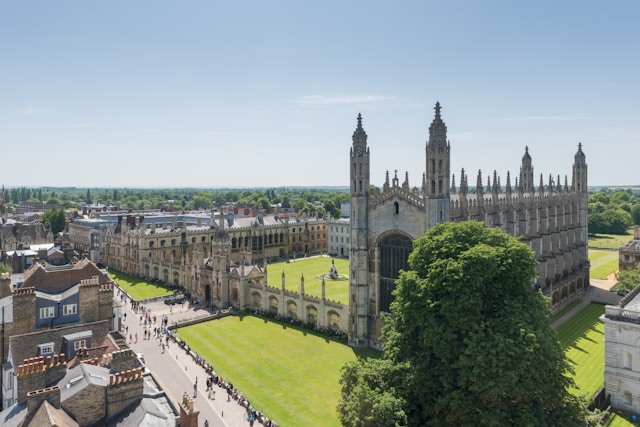
Cambridge offers another slice of illustrious academic life. The architectural beauty and the importance of knowledge are palpable around every corner of its centuries-old history and prestigious university. There’s a great deal to see here from historical sites to museums making Cambridge a popular place to visit as a day trip from London.
Colleges
Cambridge University, established in 1209, comprises 31 colleges, categorized as old and new. Each college offers accommodation and oversees student admissions and tuition. Notable colleges like Trinity, Christ’s, Pembroke, and St. John’s welcome visitors. Trinity, renowned for its Nobel laureates, features attractions like the Great Gate and Wren Library. Christ’s, associated with Charles Darwin and John Milton, boasts a historic library. Pembroke, founded in 1347, is renowned for its gardens and chapel. St. John’s, established in 1511, has a rich history and notable alumni. Visitors can explore these colleges, and enjoy self-guided tours or guided walks. Some colleges offer access to archives for educational or research purposes, providing insights into various historical periods or figures like Winston Churchill.
Museums
The Scott Polar Research Institute, part of the University of Cambridge Museums consortium, houses the Polar Museum, dedicated to the exploration and science of the Arctic and Antarctic regions. It honors Captain Robert Scott and displays artifacts from polar expeditions. Other notable museums in Cambridge include the Fitzwilliam Museum, featuring art and antiquities; the Sedgwick Museum of Earth Sciences, showcasing geological specimens; the Museum of Archaeology and Anthropology, exhibiting artifacts from various cultures and time periods, open Tuesday to Sunday; and the Museum of Zoology, displaying specimens from the animal kingdom, open daily except Monday. The bottom line is Cambridge has a museum for pretty much every interest! So you are bound to find one that definitely worth a visit.
Related: London Top Museums
The Corpus Clock
The Corpus Clock, an impressive gold-plated timepiece and art installation, is located at the junction of Bene’t Street and Trumpington Street in Cambridge. Designed to challenge traditional notions of timekeeping, it features a large disc with a grasshopper atop it, known as the Chronophage, which appears to consume seconds as they pass. Despite its accuracy, the clock’s erratic movement makes it challenging to tell the time precisely. Nearby, Great St. Mary’s Church Tower offers panoramic views of Cambridge for a small fee, situated in the historic part of the city opposite King’s College Chapel. The chapel, an iconic symbol of Cambridge, boasts stunning Gothic architecture, including the world’s largest fan vault and spectacular stained-glass windows. It remains an active place of worship and hosts concerts, renowned for its exceptional acoustics.
Cambridge Traditions
Punting on the River Cam is a popular activity in Cambridge, involving navigating flat-bottomed boats with long poles. While it can be challenging, guided tours are available, offering commentary and unique views of the city’s sights. Another Cambridge tradition is enjoying a pub lunch, with historic spots like The Eagle pub, where Watson and Crick announced their DNA findings, offering both a taste of history and classic British dishes. For a more tranquil experience, visitors can explore the Cambridge University Botanical Garden, home to diverse plant species and scenic walking trails.
Bath
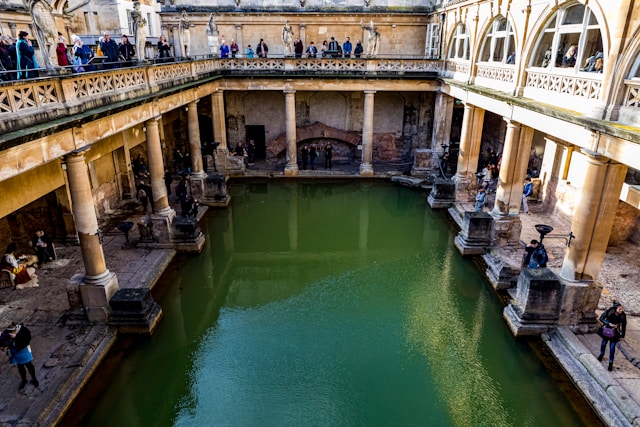
Bath, a UNESCO World Heritage City in southwest England, derives its name from ancient Roman baths renowned for their supposed healing properties. Bath boasts a rich literary history, with famous authors like Jane Austen, Charles Dickens, Anna Sewell (Black Beauty), and Mary Shelley (Frankenstein) finding inspiration in the city.
The Roman Baths
To start your tour of Bath, head to the city center and visit the iconic Roman Baths, dating back to 70AD. This complex, built atop thermal springs, was a hub for bathing and socializing in ancient times. While some parts are in ruins, others are remarkably preserved, offering a glimpse into ancient life. Explore changing rooms and plunge pools, and visit the interactive museum for a deeper understanding of the Baths’ history. Arrive early to avoid crowds; they open at 10:00 a.m. on weekdays and 9:00 a.m. on weekends.
Bath Abbey
Just a minute’s stroll from the Roman Baths lies the historic Bath Abbey, a Church of England parish dating back to the 7th century. Over its millennia-long existence, the abbey has undergone numerous transformations. With its towering architecture and intricate stained glass windows, the abbey is a sight to behold. While still a functioning church, visitors are welcome to explore its grand interior, adorned with informative placards detailing its rich history. For the adventurous, a climb up the 200-plus steps to the tower offers panoramic views of the city and surrounding countryside, perfect for capturing memorable photos.
Pulteney Bridge
Pulteney Bridge, erected in 1769, stands out as one of the UK’s most photographed bridges, featuring shops integrated into its structure, a unique trait globally. Named after Frances Pulteney, wife of the affluent William Johnstone Pulteney, the bridge offers a leisurely exploration of its quaint shops. Consider hopping on a boat from the bridge for a scenic one-hour cruise along the River Avon, passing through Bathhampton village and back. Encounter local wildlife like kingfishers and swans amidst charming scenery, leaving a lasting impression on visitors. For a comprehensive Bath experience, opt for a guided walking tour combined with a cruise.
Royal Crescent and the Circus
After your river cruise, head towards the Royal Crescent for a glimpse of iconic Georgian architecture. Before reaching there, take a brief 10-minute stroll to the Circus, a ring of identical Georgian townhouses designed by John Wood the Elder. While admiring these architectural marvels from the shaded park in the center, consider visiting the nearby Assembly Rooms, designed by John Wood the Younger, offering insights into gala civic events. These rooms now house the Fashion Museum, displaying a historic fashion collection. Next, proceed to the Royal Crescent, a five-minute walk away, originally named “The Crescent” but later earning its royal title after a visit from Prince Frederick. This crescent-shaped marvel features 30 luxury townhouses, offering a glimpse into 18th-century living at No. 1 Royal Crescent, preserved with period furnishings and household items.
Stratford-upon-Avon
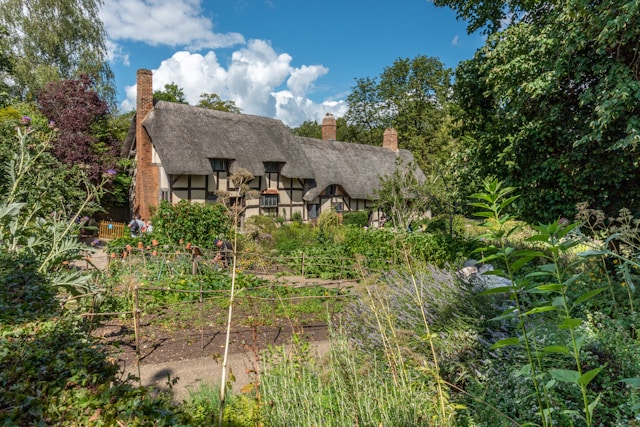
Stratford-upon-Avon is well-known as the birthplace of Shakespeare, and there are many sights in the town related to the Bard. The town itself is a medieval market town found in the Midlands of England just south of the city of Birmingham. It’s only two hours from London by train, making it a good option for a day trip from the city for those who want to learn more about Shakespeare.
Shakespeare’s Birthplace
Shakespeare’s Birthplace is a key attraction, believed to be the birth site of William Shakespeare. This 16th-century cottage on Henley Street offers insights into the Bard’s early life. Managed by the Shakespeare’s Birthplace Trust, it features six rooms and showcases the family’s history. Visitors pass through the Shakespeare Centre for additional information. Entry requires a ticket, with options for bundled tickets if visiting multiple Shakespeare sites.
Shakespeare’s Schoolroom & Guildhall
Shakespeare’s Schoolroom & Guildhall provides insight into Shakespeare’s education. The building served as both council offices and a school. Although there’s no concrete evidence of Shakespeare attending, the experience offers a glimpse into Tudor schooling. Visitors can dress in Tudor attire, try a Tudor school lesson, and experiment with quill and ink. The historic site is worth a visit to understand education in Shakespeare’s time. Additionally, the nearby Guild Chapel, dating back to the 13th century, features rare medieval wall paintings and is free to visit.
Anne Hathaway’s Cottage
Anne Hathaway’s Cottage offers insight into Shakespeare’s life after his marriage. The cottage, although actually a twelve-room farmhouse, provides a picturesque setting to explore. Operated by Shakespeare’s Birthplace Trust, it features a garden, sculpture trail, and period items. Entry requires a ticket, available online or as part of the Shakespeare story ticket. The property is located around a mile from Stratford’s center and is accessible via a short walk, taxi, or bus ride.
Other Shakespeare Buildings
Shakespeare’s New Place, purchased in 1597, served as his family home in Stratford-upon-Avon for 19 years until his death in 1616. Despite being the second largest house in Stratford at the time, it was destroyed in 1759. The grounds, now managed by the Shakespeare Birthplace Trust, are open to visitors, while the adjacent home operates as a museum. Nearby, Hall’s Croft, once inhabited by Shakespeare’s daughter Susanna and her husband, offers insight into 17th-century family life. Lastly, Holy Trinity Church, where Shakespeare was baptized, married, and buried, provides a fitting end to a journey through his life.
The Royal Shakespeare Theatre
The Royal Shakespeare Theatre owned by the Royal Shakespeare Company, stages performances of Shakespeare’s plays in a Grade II listed building seating over 1,000 people. The intimate “one-room” design, with the audience surrounding three sides of the stage, echoes the original settings of Shakespeare’s plays. The theatre shares the building with The Swan Theatre, focusing on works by Shakespeare’s contemporaries and other playwrights. The Royal Shakespeare Company also operates The Other Place, a smaller theatre for modern productions and family events. Tickets for performances should be booked in advance, and guided tours of the RSC Tower offer views of Stratford and behind-the-scenes insights. Visitors from London might consider including a visit to the Globe Theatre for a traditional theatrical experience.
Portsmouth
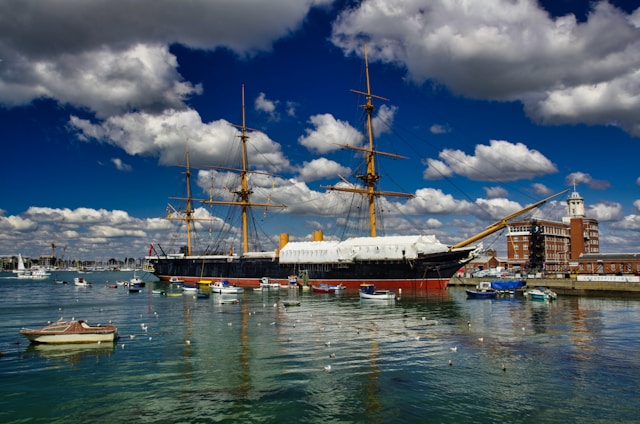
Portsmouth, located on England’s south coast, boasts a rich maritime history as one of the UK’s historic port cities and the home of the British Royal Navy. With its close proximity to London, just under two hours by train, Portsmouth offers a variety of attractions beyond its maritime heritage. While many attractions focus on the sea, visitors can also explore other facets of the city. Whether for a day trip or a longer visit, Portsmouth offers plenty of activities to explore its history and culture.
Maritime and Naval Attractions
Portsmouth’s maritime and naval attractions, centered around the Portsmouth Historic Dockyard, offer a rich historical experience. HMS Victory, the flagship of Lord Nelson during the Battle of Trafalgar, stands as a testament to British naval history. Open for visitors, it provides insight into life aboard the ship in 1805. Similarly, HMS Warrior, a steam-powered ironclad ship, showcases advancements in shipbuilding technology. Despite never seeing action, it offers a glimpse into naval innovation.
The National Museum of the Royal Navy in Portsmouth offers a comprehensive look into the history of the British Royal Navy, spanning from the 16th century to the present day. Situated across three historic buildings overlooking HMS Victory, the museum features exhibits on notable battles, present-day activities, and original artifacts such as the topsail from HMS Victory flown during the Battle of Trafalgar. Additionally, the Portsmouth Historic Dockyard, part of the Portsmouth Naval Base, houses numerous attractions including HMS M33, HMS Alliance, Action Stations, Harbour Tours, Boathouse 4, and more. Visitors can explore various naval vessels, experience physical and mental challenges at Action Stations, and enjoy temporary exhibitions.
Museums
The Mary Rose Museum in Portsmouth tells the story of the Mary Rose, a prominent warship in Henry VIII’s English navy that sank in 1545. Efforts to salvage the ship began in the mid-20th century, culminating in a successful recovery in 1983. The museum provides insights into the ship’s history, design, sinking, and recovery efforts. It offers an immersive experience, allowing visitors to learn about the vessel and its significance. In contrast, the Portsmouth Museum focuses on the history of the city of Portsmouth, featuring exhibits covering various periods and topics. Additionally, the Charles Dickens’ Birthplace Museum offers a glimpse into the life of the renowned Victorian-era author, Charles Dickens, who was born in Portsmouth in 1812. Operating under Portsmouth Museums, these museums provide opportunities for visitors to explore different aspects of history and culture.
Ready To Embark on Unforgettable Day Trips?
As your dedicated personal travel advisor, I’m here to enhance your travel experience by planning extraordinary day trips tailored to your desires.
Why Choose Me?
Tailored Experiences: I’ll create custom day trip itineraries based on your interests and preferences.
Local Insights: Discover hidden gems and off-the-beaten-path destinations with my insider knowledge.
Stress-Free Planning: Sit back and relax as I handle all the details, making your day trips hassle-free.

